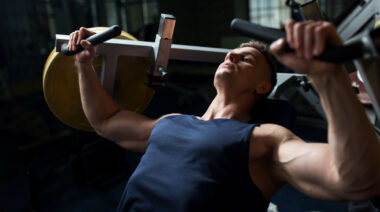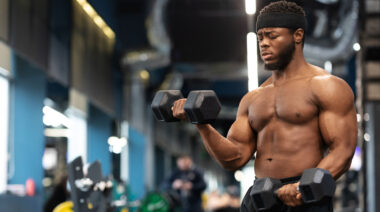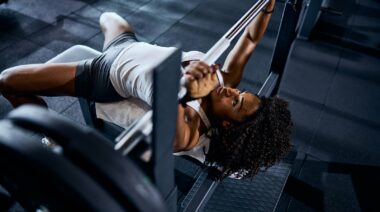What is the makeup of a great MMA fighter? I will not be going into the technical mastery of various martial arts, but looking at it more from the strength and conditioning coach point of view. An MMA fighter has to be strong enough to dominate the opponent, throw powerful punches and kicks, absorb impact, and be able to resist a constant application of force. He or she has to be powerful and fast, and have enough endurance to be able to perform at high level for five 5-minute rounds. The training program has to address all of the above qualities without compromising one another. This is the beauty of strength and conditioning training for combat sports – as an S&C coach you are a part of a team that creates such a well-rounded athlete.
The training program I’m sharing here on Breaking Muscle has been prepared for a professional MMA fighter, Richie J. Edwards. The first eight sessions are part of his strength phase. The sessions have been presented exactly as they happened without modifications, so you will be able to see when they had to be changed or when Richie was under-recovered. I have used a linear periodization method this time and trained Richie two times per week. Following his strength phase, we moved into a power phase. For you, we will be posting three sessions per week, but you can adjust them to fit your own MMA or BJJ training schedule.
Before you look at the training sessions themselves, lets look at the way I structure my strength phase. First of all, you will not see any sledgehammers, battle ropes, tire flips, or training with a gas mask or snorkel. It doesn’t mean I don’t see a place for these (maybe apart from gas mask and snorkel – as these have no place in my sessions). We do use tires and ropes, however I use them more during the power and endurance development, which happens closer to a fight.
When I create programs for and train my athletes I consider the following factors:
1. Always follow a Hippocratic oath to do no harm.
There are still some strength and conditioning coaches out there who train the fighters as if the gym, not the cage, was their main sport. If your athlete gets seriously injured during a conditioning session and you jeopardize his/her career because of it, it means you failed as a trainer. Therefore the selection of exercise and equipment according to athlete’s ability is so important. The gym is not a place to take risks.
Let’s take a sledgehammer as an example. Who remembers David Faulkner from The Ultimate Fighter U.S. versus U.K., when he missed the tire and instead hit the concrete and his leg with a sledgehammer? Does it mean that sledgehammer exercises are bad? Not at all, it just means he shouldn’t have been doing it, as he had no idea how to use the sledgehammer. Sometimes the exercises that look cool are not the best choices. I am not saying they are not effective, but the problem is that if you can develop the same qualities using much safer options, so why not do that? If as a coach you do decide that smashing a tire with a sledgehammer will give your fighter an edge, make sure he/she knows how to use the tools before they attempt to do so. Your job is to make sure the sessions are effective and safe and they contribute to your athlete becoming a better fighter, which brings us to point number 2.
2. Repeated from a great coach, Dan John: Remember that the goal is the goal.
Seems pretty obvious, but how often do you see trainers who have an ambition to make their fighters the best deadlifters, best sprinters, marathon runners, or even Olympic lifters. The goal is the goal. I know only one example where the gym became a sport and that is CrossFit. If you want to be good in the CrossFit Games, CrossFit training is the way to go, but it doesn’t mean it is a good way to train a fighter. Quite the opposite. To give another example, what works for a powerlifter will not necessarily work for a fighter. Work on the programs with the goal in mind, remember to test and assess your athletes. If you find out that poor mobility is what stops your athlete from increasing strength, address the mobility first before putting more weight on the bar.
3. Strength and conditioning should not dominate the fighting practice and technical sessions.
Strength and conditioning sessions are supporting sessions to all other training. If because of your training the athlete is so sore for a couple of days that they have to miss their fighting practice, you did fail as a trainer. It may happen that you want to increase the intensity of your strength and conditioning sessions, but always make sure it does not conflict with the fighting practices.
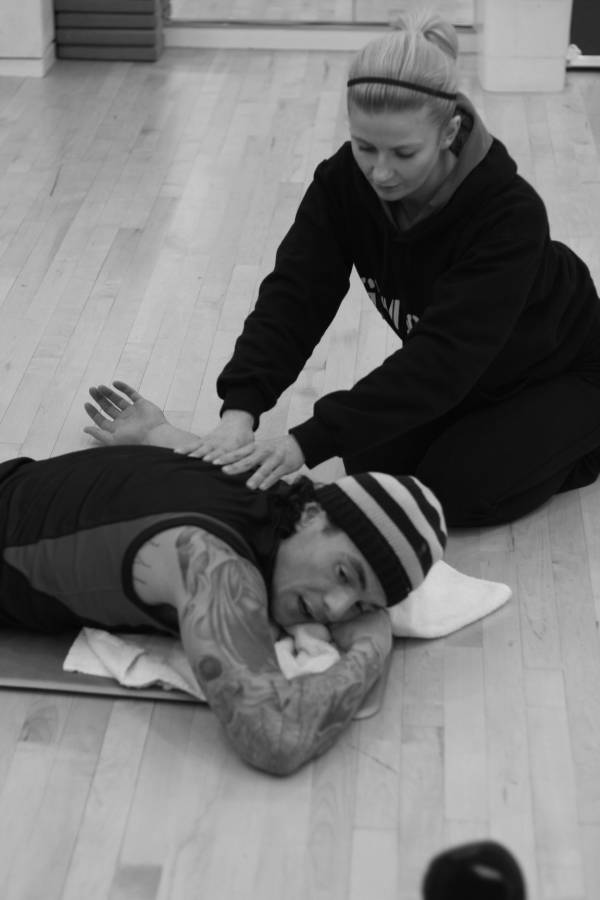
Also, if it happens that you pushed too hard (which most likely will happen or has already happened to all of us at some point), make a note in the training log and adjust the intensity. The more you know your athlete, the more you can fine-tune the training. This is why I do not believe in six of eight week training camps. To know your athlete well, you need to work with them on a regular basis.
4. Look at the situation and adapt.
The training has been going great and your athlete is responding well to the sessions. All is going according to the plan. Then one day, the day you have planned a heavy session, the fighter comes in completely battered and says he just did a heavy sparring session, as he had to help his friend, who is getting ready for a fight. How many times has a similar scenario happened to you? Would you even consider sticking to your program on such a day? The answer is that you have to adapt. Sometimes the fighters come to you and their bodies are completely broken. Your job is to build them back up, not to exhaust them even more. You still need to remember about your goal, however. So whatever you do on the day has to contribute to the goal itself.
5. Do not use more than two heavy lifts per session.
During my strength training sessions I do not use more than two heavy, multi-joint, compound lifts. Sometimes I use only one. It all depends how much time we have for a session and the athlete’s ability on the day. All other exercises done are supplemental work that complements the training and contributes to the strength development
6. Observe and record your athlete in detail.
Whilst training and assessing I look at the load, technique, the number of repetitions, and the speed at which the weight is moved, which is very important. All of the above are always logged for the future information. For example, let’s say that Richie deadlifts 80% of his 1RM x 5, but the bar moves slowly. He struggles with the last 2 reps but manages to complete them with correct technique. I have made a note in his training log, “1x 5 @ 80% 1RM DL.” A couple of sessions later, he repeats exactly the same drill, but this time the bar moves quickly. He doesn’t struggle and there is no decrease in the speed at which he moves the bar. Does it mean he got stronger? Yes, but if I only make a note “1×5@80% 1RM DL” it doesn’t tell me that there has been an improvement. I must also note the speed of the bar.
7. Do not test often for 1RM.
I don’t test for 1RM more than two times per year, as it is a huge stress for the central nervous system (CNS). Most of the fighters I work with need to cut weight for competitions, so we mostly work within 1-6 reps, 80-95% 1RM range, to target the CNS.
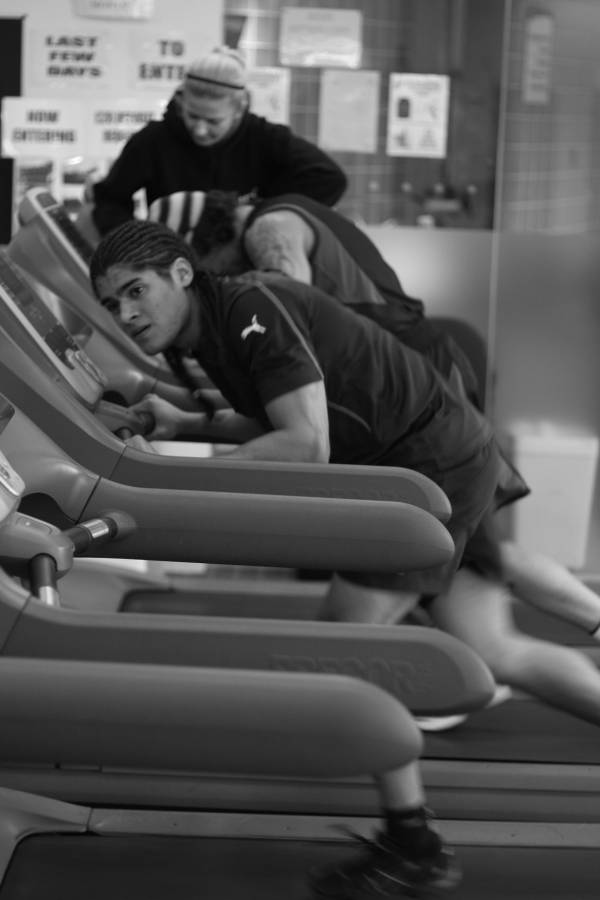
8. Keep it simple.
I like keeping the strength training pretty simple. Exercise selection for strength phase includes deadlift, front and back squat, overhead squat, military (strict) press, bench press, different modification of rows, pull ups (weighted or bodyweight), and various core exercises. The basic principle is to include movements like pull, push, lift, squat, and twist/rotate.
9. Observe and compare your strength standards.
At my gym, CJS Combat, we set standards for our combat athletes to make sure they are well rounded and developed in all areas. Our standards for strength are as follows:
- Deadlift – 2xBW
- Back Squat – 1.75xBW
- Front Squat – 1.5xBW
- Overhead Squat – 5 reps @ 1xBW
- Bench Press -1.5xBW
- Military Press – 0.9xBW
- Pull Up (Weighted) – BW + .5BW
Please note the standards above do not include Olympics lifts and their derivatives, as they are included in our standards specifically for power development.
This is only a short introduction, but it explains the basics upon which we structure our strength sessions. Training is based on science, but it is also an art. In the end there are no right or wrong answers. In the end whatever works is what works, and sometimes it is not what you read in the books.
Watch one of Sabina’s sessions with Richie:
Week 1, Day 1: Strength Phase, Day 1
Warm up with joint mobility
A.
3 Rounds:
Barbell Russian Twist: 20kg BB + 15kg x 10 (L&R counts as 1)
Every round change the level:
- Round 1 – Top of the thigh
- Round 2 – Just below the knee
- Round 3 – Down to the floor
B.
Build up to Front Squat 1RM: 95kg
3 Rounds of 3 reps at 45% 1RM (See notes on time under tension below)
Rest 3 mins between rounds
Looks like:
- Eccentric: 16sec
- Bottom hold (thighs parallel to the floor): 8sec
- Concentric: 1sec
C.
4 Rounds:
8x Stiff Legged Deadlift (off a box): 30 % 1RM – 50kg
16kg Dumbbell Isometric Ab Work x 8: Sitting on a bench, hook one foot against a bar on the Smith machine, press against the bar with the other foot. Lean back until you feel most tension in your abdominals. Maintaining this position, Richie did 8 dumbbell presses per arm.
D.
Flexibility work
Notes on Time Under Tension (TUT): Time under Tension method is well known as very effective in increasing strength, muscle size, or muscle endurance depending on how you use it. When you look at TUT you look at the total amount of work you place on a muscle and the total time muscles resist weight during each set. For example, you could do 5 chin ups with the tempo of 1 sec up, 2 sec hold at the top position, 3 sec lowering down. The time to perform each rep will be 6 seconds, with a total of 5 reps. Therefore the total TUT for this set is 30 seconds.
The traditional protocol for TUT when looking at improving STRENGTH is:
1-6 reps
TUT: 4-24 sec
Load 50% 1RM +
Seconds per rep:
1 rep: 4 – 20
2 reps: 2-10
3 reps: 2-6
Strength and conditioning coaches have tweaked these values based on their own experience, so you may see different numbers out there depending what literature you read. Here is what I have come up with for Richie.
This is first time I used TUT with Rich and the goal was to improve his Front Squat 1RM and also his chin ups. Chin ups followed the traditional protocol with a small change, so I am not going to elaborate on that. However, with squats, the story was completely different.
The protocol I have followed for squats over 3 weeks time was:
Session 1:
3 sets of 3 reps @ 45% of 1RM
16/8/1 **
Rest 3 minutes between sets, short rest up to 30 seconds between reps allowed to correct the grip.
Session 2
3 sets of 3 reps @ 47% of 1RM
14/8/1 **
Rest 3 minutes between sets, short rest up to 30 seconds between reps allowed to correct the grip.
Session 3
3 sets of 3 reps @ 50% of 1RM
12/8/1 **
Rest 3 minutes between sets, short rest up to 30 seconds between reps allowed to correct the grip.
** Eccentric (lowering down)/isometric (hold – thighs parallel to the floor)/concentric (stand up)
As you can see, it differs from the traditional programming. I have decreased the load but increased the time and also allowed for a short break between each repetition. Again, the numbers above are based on experience and they may differ for other athletes. I found this range of time, rest and reps very effective when introducing TUT for the first time. I wouldn’t use it more than 2x a year for big exercises like squat and bench press. I haven’t used it for deadlifts and would not recommend doing so, as I personally think it puts too much stress on the back.
Always remember that the form is crucial, so if technique is compromised, decrease the time per rep or load. When you use TUT for the first time, you will be stunned by the results, which leads to the temptation to used it more often. I have tried different scenarios, and the one that has worked best so far was TUT 2 times each year for big lifts. I have not noticed any significant improvement in strength when I increased the frequency of TUT sessions.
Give it a go, play with it, and always remember training = science + art. There are always new ways to explore. I like using TUT with fighters for a couple of more reasons, one of the most important is that using lower load for few reps puts less stress on the joints and you still get the benefits and improvement in strength.
Week 1, Day 2: Strength Phase, Day 2
Warm up with joint mobility etc
A.
2 x Pull Up Ladder 5-1
Tempo:
- Concentric: 1 sec
- Isometric (hold at the top): for 2 sec
- Eccentric (lower down to full extension): 3 sec
B.
Deadlift
Build up to 100 kg then:
- 5 x @ 100kg
- 5 x @ 110kg
- 3 x @ 120kg
- 2 sets of 3 x @ 128kg (80% 1RM)
C.
Assisted Glute Ham Raise: 4 rounds, 6 reps
D.
Leg Raises x 6 per side @16kg
Tempo:
- Concentric (up) 1 sec
- Eccentric (lower down) 3 sec
E.
16kg Dumbbell Isometric Ab Work x 8: Sitting on a bench, hook one foot against a bar on the Smith machine, press against the bar with the other foot. Lean back until you feel most tension in your abdominals. Maintaining this position, Richie did 8 dumbbell presses per arm.
Week 1, Day 3: Strength Phase, Day 3
Today’s session is still a part of the strength cycle, but the load is not sufficient for strength development. For us, strength phase is all about getting the athlete stronger through improvement of various qualities. Today, as it is our third strength and conditioning session this week, we have decreased the intensity and will now focus on improving mobility and structural awareness, which will help you tolerate a heavier load.
Warm up with joint mobility.
10-9-8-7-6-5-4-3-2-1 of each
Overhead Squat (OHS) @ 30 kg – Focus on technique and alignment
Pull Up
Strict Press @ 30kg – Focus on technique and alignment
Looks like: 10 x OHS, 10 x pull up, 10 x strict press, 9x OHS, 9x pull up, 9 x strict press, down to 1 of each.
Cool down and stretch.
Click on the number below that corresponds to your training week.
Week 2, Day 1: Strength Phase, Day 4
Warm up with joint mobility
A.
3 rounds of 3 reps at 47% 1RM: 45kg (Time under tension as below)
Looks like:
- Eccentric 14sec
- Bottom hold (thighs parallel to the floor) for 8 sec
- Concentric 1 sec
Rest 3 mins between rounds
B.
Build to 1RM strict press – 60kg
4×3 @ 80 % of 1 RM – 48kg
C.
4 Rounds:
6 x (per side) @20kg Dumbbell Isometric Abs Work
D.
Neck conditioning drills
Week 2, Day 2: Strength Phase, Day 5
Warm up
A.
3 Rounds:
Single Legged Deadlift (body weight only ) x 8 per leg
Kettlebell swings @ 16kg x 10
Knee Jump x 5
B.
Build up to heavy Deadlift
2 sets 2 reps @ 120kg
4 sets 3 reps @ 130kg
Rest 2 mins between sets
C.
Pull Up Ladder
3 x 5-1 tempo (1-2-3) Up on 1, hold for 2 sec, eccentric 3 sec.
3 x 1 min Static Hold + body weight and 10kg +
Rest 1 min between
Cool down and flexibility work
Week 2, Day 3: Strength Phase, Day 6
Warm up with joint mobility
A.
Front Squat
3 rounds of 3 reps at 50% 1RM: 47.5 kg (Time under tension as below)
12/8/1
Looks like:
- Eccentric: 12 sec
- Bottom hold (thighs parallel to the floor): 8 sec
- Concentric: 1 sec
B.
Strict press: 4 x5 @ 48 kg (80% 1RM)
C.
Rowing interval
5 x 30sec @ > 135m; 1 min rest
- 142m @ 32 s/m (strokes per minute rate)
- 134 @ 32 s/m
- 134 @ 30 s/m
- 137 @ 34 s/m
- 137 @ 34 s/m
Cool down and flexibility work
Click on the number below that corresponds to your training week.
Week 3, Day 1: Strength Phase, Day 7
Warm up with joint mobility, swings, jumps, etc.
A.
Build up to 80 % Front Squat – 76 kg
4 sets of 5 reps @ 76kg
2 mins active rest between sets.
B.
Deadlift: build up to 80% 1RM (130kg)
4 sets of 3 reps @ 130kg
Rest as above.
C.
4 Sets:
Smiths Machine Isometric Abs work 8 x @ 20kg
30 m Farmers Carry @ bodyweight (½ bodyweight per arm): 2x 35kg Dumbbell
Then cool down and flexibility work.
Week 3, Day 2: Strength Phase, Day 8
Warm up with joint mobility.
A.
3 Rounds:
10 x KB swing @ 16 kg
5 x Knee Jump
5 x Squat Jump
(Focus on explosive hip drive)
B.
Barbell Russian Twist – 20kg Barbell x 10 (Left & Right counts as 1)
Every round change the level:
Round 1: Top of the thigh
Round 2: Just below the knee
Round 3: Down to the floor
C.
Front Squat 1 RM test
New PR – 105 kg
Richie’s weight is 73kg at the moment, which makes him nearly reach the Front Squat standard, which is 1.5x Bodyweight. I have not tested deadlifts, as we worked up to 160kg in the past, which means he already is able to lift required weight. I look more at the speed at which he moves the bar when performing the deadlift and I will focus on building him up to be able to complete more repetitions at 80% -90% his 1RM.
D.
Strict Press
Build up to 50 kg (83% 1RM)
4 x 3 reps @ 50 kg
2 mins active rest between sets.
E.
Light Overhead Squats (Structural, working on opening up the chest)
3 x 8 @ 30kg
F.
Box Jumps @ 24” 3 x5 reps (Focus on controlled landing)
G.
Mobility work
NOTES: Today marks the final day of the Strength Phase. We have tested Front Squat 1RM. I have tested Front Squat only because this was the lift that was hard for Rich to improve. It was also the first lift with which we used TUT method. Today Richie got his new personal record – 105 kg (his previous 1RM was 95kg). What was even more important for me, is the fact that he could comfortably squat 95kg for 3 repetitions at a very good speed. The new 1RM was clean with good technique.
Week 3, Day 3: Power Phase, Day 1
Warm up with joint mobility.
A.
3 Rounds:
10 sec work/1 min rest
Warrior star jump (aim for 10 reps)
Round 1 – 8 reps
Round 2 – 8 reps
Round 3 – 9 reps
Rest 2 mins
B.
3 Rounds:
10 sec work/1 min rest
Sprawl (aim for 7+)
Round 1 – 8
Round 2 – 7
Round 3 – 8
C.
Hang clean technique recap; build up to 57.5kg Hang Clean
4×3 reps @ 57.5kg Hang Clean + 5x Tuck Jump
Active Rest: 2 mins in between rounds
D.
4 Rounds of 20 sec work and 10 sec to change the position (4 mins in total):
1 round looks like:
V Sit Up: 20 sec
Gecko: 20 sec (In the plank position bring one knee to your elbow and alternate – aim for 1 rep per second, right knee to right elbow, left knee to left elbow etc)
Cool down and flexibility work
Click on the number below that corresponds to your training week.
Week 4, Day 1: Power Phase, Day 2 (Video Below)
Warm up with joint mobility.
A.
3 Rounds:
10 seconds Warrior Star Jumps (aim for 10)
10 seconds Sprawl (aim for 8 +)
Round 1:
Star Jumps x9
Sprawl x 9
Round 2:
Star Jumps x 9
Sprawl x 7
Round 3:
Star Jumps x 9
Sprawl x 9
Then
3 rounds of
6 x jump over 24″ box
B.
3 Rounds:
6 x Jump Over to Shoot
Round 1 24″ box, round 2 26″ box, round 3 26″ box
C.
Work on Power Clean (PC) and Hang Clean (HC) technique
Then:
3 x PC + 3 x HC @ 52.5 kg
3 x PC + 3 x HC @ 57.5 kg
3 x PC + 3 x HC @ 60 kg
3 x PC + 3 x HC @ 62.5 kg – 80% 1RM for PC (2 rounds)
Rest 2 mins between rounds.
D.
5 rounds of 30 sec work; 1 min work
Deadmill (Run on a treadmill without switching it on)
Cool down and flexibility work.
Week 4, Day 2: Power Phase, Day 3
Warm up with joint mobility.
A.
15 sec, work 50 sec rest (15/50)
3 Rounds:
Ball Slam @ 5kg medicine ball (not bouncy)
Round 1 x 12
Round 2 x 13
Round 3 x 15
Rest 90 secs
B.
3 Rounds of 15/50
Warrior Star Jump (Aim for 15reps)
Round 1 x 14
Round 2 x 15
Round 3 x 14
Rest as above
C.
3 Rounds of 15/50
Sprawl (Aim for 11+)
Round 1 x 10
Round 2 x 12
Round 3 x 13
Rest as above
D.
3 Rounds of 6 reps:
Ball Chest Pass (w/5kg medicine ball) to Sprawl: Focus on speed
Rest 90 sec between rounds
E.
Build up to 62.5kg Power Clean and
5 x 3 reps @ 62.5kg (80% 1RM)
Rest 2 mins between rounds
F.
Split jerk technique recap
4 x 3 reps @ 42.5 kg – focus on speed.
Cool down and flexibility work
Week 4, Day 3: Power Phase, Day 4
Note: Richie was pretty tired after hard sparing session a day before. He said his legs felt heavy, so the session focuses mostly on pushing .
Warm up with joint mobility
A.
4 Rounds:
Push Ups x 6 (+ 10kg disc on Richie’s back): Controlled down, fast up ( hands remain on the floor)
Clapping Push Up x 6: Explode as high as possible each time
Rest 2 mins between rounds
B.
Build up to 80% 1RM Jerk and @ 62.5kg
4 Rounds:
Jerk x 3
Medicine Ball Slam x 6 (6 kg med ball)
Medicine Ball Chest Pass x 6 – focus on speed
Rest 2mins, 30 sec between rounds or longer if the form and/or speed is compromised.
C.
3 rounds of 8 reps (controlled)
Inverted Row (Parallel to the floor, chest has to touch the bar)
D.
3 Rounds of Cable Column Wood Chop
8 x each side @ 41kg (90lbs)
E.
3 x 100m row @ 20 sec or below pace
Rest 1 min in between
- 20.03 sec @ 38 s/m
- 20.04 sec @ 38 s/m
- 20.01 sec @ 36 s/m
Cool down and flexibility work

